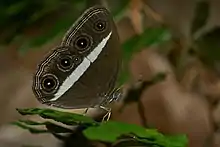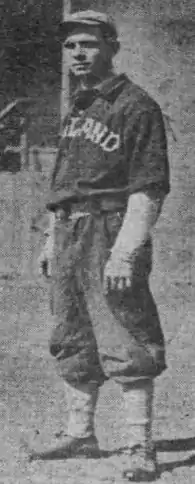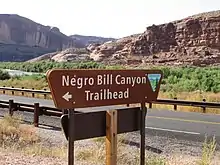Use of nigger in proper names
The word nigger has historically been used in the names of products, colors, plants, as place names, and as people's nicknames, among others, but has fallen out of favor since the 20th century.
Commercial products

In the US, the word nigger featured in branding and packaging consumer products, e.g., "Nigger Hair Tobacco" and "Niggerhead Oysters". As the term became less acceptable in mainstream culture, the tobacco brand became "Bigger Hair" and the canned goods brand became "Negro Head".[1][2] An Australian company produced various sorts of licorice candy under the "Nigger Boy" label. These included candy cigarettes and one box with an image of an Indian snake charmer.[3][4][5] Compare these with the various national varieties and names for chocolate-coated marshmallow treats, and with Darlie, formerly Darkie, toothpaste.
Plant and animal names

Some colloquial or local names for plants and animals used to include the word "nigger" or "niggerhead".
The colloquial names for echinacea (coneflower) are "Kansas niggerhead" and "Wild niggerhead". The cotton-top cactus (Echinocactus polycephalus) is a round, cabbage-sized plant covered with large, crooked thorns, and used to be known in Arizona as the "niggerhead cactus". In the early 20th century, double-crested cormorants (Phalacrocorax auritus) were known in some areas of Florida as "nigger geese".[6] In some parts of the U.S., Brazil nuts were known as "nigger toes".[7]
The "niggerhead termite" (Nasutitermes graveolus) is a native of Australia.[8]
Colors
A shade of dark brown used to be known as "nigger brown" or simply "nigger";[9] other colors were also prefixed with the word. Usage as a color word continued for some time after it was no longer acceptable about people.[10] Nigger brown commonly identified a colour in the clothing industry and advertising of the early 20th century.[11]
Nicknames of people

During the Spanish–American War US Army General John J. Pershing's original nickname, Nigger Jack, given to him as an instructor at West Point because of his service with "Buffalo Soldier" units, was euphemized to Black Jack by reporters.[12][13]
In the first half of the twentieth century, before Major League Baseball was racially integrated, dark-skinned and dark-complexioned players were nicknamed Nig;[14][15] examples are: Johnny Beazley (1941–49), Joe Berry (1921–22), Bobby Bragan (1940–48), Nig Clarke (1905–20), Nig Cuppy (1892–1901), Nig Fuller (1902), Johnny Grabowski (1923–31), Nig Lipscomb (1937), Charlie Niebergall (1921–24), Nig Perrine (1907), and Frank Smith (1904–15). The 1930s movie The Bowery with George Raft and Wallace Beery includes a sports-bar in New York City named "Nigger Joe's".
In 1960, a stand at the stadium in Toowoomba, Australia, was named the "E. S. 'Nigger' Brown Stand" honoring 1920s rugby league player Edwin Brown, so ironically nicknamed since early life because of his pale white skin; his tombstone is engraved Nigger. Stephen Hagan, a lecturer at the Kumbari/Ngurpai Lag Higher Education Center of the University of Southern Queensland, sued the Toowoomba council over the use of nigger in the stand's name; the district and state courts dismissed his lawsuit. He appealed to the High Court of Australia, who ruled the naming matter beyond federal jurisdiction. At first some local Aborigines did not share Mr Hagan's opposition to nigger.[16] Hagan appealed to the United Nations, winning a committee recommendation to the Australian federal government, that it force the Queensland state government to remove the word nigger from the "E. S. 'Nigger' Brown Stand" name. The Australian federal government followed the High Court's jurisdiction ruling. In September 2008, the stand was demolished. The Queensland Sports Minister, Judy Spence, said that using nigger would be unacceptable, for the stand or on any commemorative plaque. The 2005 book The N Word: One Man's Stand by Hagan includes this episode.[16][17]
Place names
Many places in the United States, and some in Canada, were given names that included the word "nigger", usually named after a person, or for a perceived resemblance of a geographic feature to a human being (see Niggerhead). Most of these place names have long been changed. On July 27, 1962, citing a standard of "offensive to many", and "no one now would suggest a new name including the word", Secretary of the Interior Stewart Udall sent a letter to the United States Geological Survey's board chairman to press for a plan to remove the use of the word "nigger" anywhere it appeared in the organization's topographical maps product, and to request a policy for and change of all occurrences of it on its maps.[18][19] This led to a wider codified policy by the USGS against use of any ethnic slur in any map name. Where "nigger" appeared on USGS map objects and another suitable name had not been offered, it was changed to "negro", by 1967.[18]
In West Texas, "Dead Nigger Creek" was renamed "Dead Negro Draw";[20] both names probably commemorate the Buffalo Soldier tragedy of 1877.[21] Curtis Island in Maine used to be known as either Negro[22] or Nigger Island.[23] The island was renamed in 1934 after Cyrus H. K. Curtis, publisher of the Saturday Evening Post, who lived locally.[24] It had a baseball team who wore uniforms emblazoned with "Nigger Island" (or in one case, "Nigger Ilsand").[25] Negro Head Road, or Nigger Head Road, referred to many places in the Old South where black body parts were displayed in warning (see Lynching in the United States).
In Los Angeles, Nigger Alley or Negro Alley was used on maps to signify the street originally called Calle de los Negros in the Spanish and Mexican period, referring to Afromestizo or mulatto Mexican residents.[26]
Some renamings honor a real person. As early as 1936, "Nigger Hollow" in Pennsylvania, named after Daniel Hughes, a free black man who saved others on the Underground Railroad,[27] was renamed Freedom Road.[28] "Nigger Nate Grade Road", near Temecula, California, named for Nate Harrison, an ex-slave and settler, was renamed "Nathan Harrison Grade Road" in 1955, at the request of the NAACP.[29]
Sometimes other substitutes for "nigger" were used. "Nigger Head Mountain", at Burnet, Texas, was named because the forest atop it resembled a black man's hair. In 1966, the First Lady, Lady Bird Johnson, denounced the racist name, asking the U.S. Board on Geographic Names and the U.S. Forest Service to rename it, becoming "Colored Mountain" in 1968. Other renamings were more creative. "Nigger Head Rock", protruding from a cliff above Highway 421, north of Pennington Gap, Virginia, was renamed "Great Stone Face" in the 1970s.
Some names have been metaphorically or literally wiped off the map. In the 1990s, the public authorities stripped the names of "Niggertown Marsh" and the neighbouring Niggertown Knoll in Florida from public record and maps, which was the site of an early settlement of freed black people.[30] A watercourse in the Sacramento Valley was known as Big Nigger Sam's Slough.[31]

Sometimes a name changes more than once: a peak above Santa Monica, California was first renamed "Negrohead Mountain", and in February 2010 was renamed again to Ballard Mountain, in honor of John Ballard, a black pioneer who settled the area in the nineteenth century. A point on the Lower Mississippi River, in West Baton Rouge Parish, that was named "Free Nigger Point" until the late twentieth century, first was renamed "Free Negro Point", but currently is named "Wilkinson Point".[32] "Nigger Bill Canyon" in southeast Utah was named after William Grandstaff, a mixed-race cowboy who lived there in the late 1870s.[33] In the 1960s, it was renamed Negro Bill Canyon. Within the past few years, there has been a campaign to rename it again, as Grandstaff Canyon, but this is opposed by the local NAACP chapter, whose president said "Negro is an acceptable word".[34] However the trailhead for the hiking trail up the canyon was renamed in September 2016 to "Grandstaff Trailhead"[35] The new sign for the trailhead was stolen within five days of installation.[36]
A few places in Canada also used the word. At Penticton, British Columbia, "Niggertoe Mountain" was renamed Mount Nkwala. The place-name derived from a 1908 Christmas story about three black men who died in a blizzard; the next day, the bodies of two were found at the foot of the mountain.[37] John Ware, an influential cowboy in early Alberta, has several features named after him, including "Nigger John Ridge", which is now John Ware Ridge.[38]
References
- Ravernell, Wanda J. (June 15, 2005). "What's cute about racist kitsch?". San Francisco Chronicle. Retrieved March 13, 2006.
- "Jim Crow Museum". Ferris State University. Retrieved March 13, 2006.
- "More Racist Licorice". Blah blah blah. November 30, 2008.
The other day I posted about Nigger Boy Licorice, a brand of sweet that was popular in Australia for many years up until the mid-1960s when it was suddenly realised that people found the name Nigger Boy to be offensive rather than amusing. ... I do have a few various offensive advertisements that the company made.
- Best, Daniel (March 16, 2007). "Racist Comic Book Ads". 20th century Danny Boy. Retrieved May 16, 2016.
... the one thing I did show which left everyone in the room speechless was this ad, taken from an old Australian comic (I think it was a Dagwood comic. I have it downstairs buried in a box somewhere). If the ad wasn't enough then what really stunned people was when I told them that this ad appeared in all it's [sic] glory in the mid to late 1960s. There was more discussion about this ad and it's merits [sic] than anything else in the entire course ...
- Museum Victoria. "Advertisement - Nigger Boy Licorice, 1950s-1960s". Museum Victoria Collections. Retrieved May 16, 2016.
- Williams, John (1919). "Notes on Birds of Wakulla County, Florida" (PDF). Wilson Bulletin. Retrieved July 30, 2015. Cite journal requires
|journal=(help) - Brazili, Matt (July 14, 2000). "Actually, My Hair Isn't Red". The Wall Street Journal. Dow Jones & Company, Inc. Retrieved November 15, 2014.
Hearing angmo so often took me back to my childhood, when my friends and I used the words Jew and Gyp (the latter short for Gypsy) as verbs, meaning to cheat. At that time, in the 1960s, other racial epithets, these based on physical appearance, were commonly heard: cracker, slant-eye, bongo lips, knit-head. To digress to the ludicrous, Brazil nuts were called "nigger toes."
- "Semiochemicals of Nasutitermes graveolus, the Niggerhead termite". The Pherobase. Retrieved March 12, 2006.
- "Target Wools advertisement". Vogue Knitting Book (33). c. 1948.
Nigger and Pink Cardigan
- "Hue & Cry". Urban Legends Reference Pages: Racist Sofa Label. Retrieved August 11, 2007.
- Allan, Keith (July 20, 2016). "Contextual determinants on the meaning of the N word". SpringerPlus. 5 (1): 1141. doi:10.1186/s40064-016-2813-1. ISSN 2193-1801. PMC 4954799. PMID 27504239.
- "Buffalo Soldier Cavalry Commander: General John J. Pershing". U.S. National Park Service. Archived from the original on September 15, 2007. Retrieved August 17, 2007.
- Vandiver, Frank E. Black Jack: The Life and Times of John J. Pershing – Volume I (Texas A&M University Press, Third printing, 1977) ISBN 0-89096-024-0, p. 67.
- "1920: Corsicana's Finest Hour". Archived from the original on December 28, 2007.
- "Jay Justin "Nig" Clark of Navarro County, Texas".
- Monaghan, Peter: Taking a Stand, July 29, 2005 in The Chronicle of Higher Education, available at "Australia's E. S. 'Nigger' Brown Stand and "Judicial Restraint"". Prof. Andrew V. Uroskie. July 29, 2005. Retrieved September 27, 2008.
- Bita, Natasha (September 27, 2008). "League legend would have wanted sign to stay: grandson". The Australian. Retrieved September 27, 2008.
- Monmonier, Mark (2008-09-15). From Squaw Tit to Whorehouse Meadow: How Maps Name, Claim, and Inflame. University of Chicago Press. pp. 44–45. ISBN 978-0-226-53464-0.
- "US Geological Survey (USGS) briefing materials on Derogatory Names Policy, 2017" (PDF). Retrieved 2020-06-14.
- "Dead Negro Draw". Handbook of Texas Online. Retrieved February 19, 2010.
- "From Negro Creek to Wop Draw, place names offend". NBC News. February 26, 2012. Retrieved February 6, 2015.
- Island chronicler Charles McLane says "Curtis Island was known as Negro Island from Revolutionary Times to the 1930s ..." McLane, Charles B.; McLane, Carol Evarts (1997). Islands of the Mid-Maine Coast. I. Gardiner, ME; Rockland, ME: Tilbury House; Island Institute. p. 124. ISBN 978-0-88448-184-3.
- An early postcard shows it as "Nigger Island." cf.CardCow.com. "CardCow.com Postcard Sale site". Nigger Island Lighthouse, Camden Maine. Retrieved April 17, 2012.
- McLane, Islands of the Mid-Maine Coast Vol. I at p. 124
- Lukas, Paul (September 13, 2012). "Question Time, Vol. 2". Uni Watch: The Obsessive study of athletic aesthetics. Retrieved May 3, 2016.
- Lopez, Cesar (2012). "Lost in Translation: From Calle de los Negros to Nigger Alley to North Los Angeles Street to Place Erasure, Los Angeles 1855–1951" (PDF). Southern California Quarterly. 94 (1 (Spring 2012)): 39–40. doi:10.1525/scq.2012.94.1.25. JSTOR 10.1525/scq.2012.94.1.25.
- Lou Hunsinger Jr. "Daniel Hughes: Giant of Freedom Road". Williamsport Sun-Gazette. Archived from the original on April 20, 2012. Retrieved February 15, 2012.
- Bob Hill. "Forests & Freedom: Forgotten Links In Pennsylvania's Underground Railroad". The Resource a publication of the Pennsylvania Department of Conservation and Natural Resources. Retrieved June 27, 2007.
- "Nathan Harrison (1823–1920)". San Diego Biographies. San Diego Historical Society. Archived from the original on December 10, 2007. Retrieved July 1, 2011.
- Racial slurs deleted from Fla, maps JET, (magazine), July 1992, Johnson Publishing
- Fleming, Thomas C. (1999). BLACK LIFE IN THE SACRAMENTO VALLEY 1919-1934. Boson Books. Retrieved May 3, 2016.
- "Free Negro Point". USGS Geographic Names Information System. Retrieved March 12, 2006.
- Van Cott, John W. (1990). Utah Place Names. Salt Lake City, Utah: University of Utah Press. pp. 271–272. ISBN 978-0-87480-345-7.
- McCombs, Brady (November 26, 2012). "Push on to rename 'Negro Bill Canyon' in Utah". Salt Lake Tribune. Salt Lake City. Associated Press. Retrieved March 29, 2015.
- Maffley, Brian (September 23, 2017). "Negro Bill Trailhead renamed to a more sensitive moniker in honor of southern Utah pioneer".
- Maffley, Brian (September 29, 2017). "Vandals steal BLM's new Grandstaff Trailhead sign at Moab's Negro Bill Canyon".
- "Niggertoe Mountain". BC Geographical Names.
- Canadian Geographical Names. Natural Resources Canada.